Perhaps thousands of years before people invented the wheel, a nomadic hunter looked out of his cave somewhere in the wintry regions of central Asia. He was disheartened by the knee-deep layer of snow he’d trudge through to reach his hunting grounds. As he wrapped himself in layers of animal furs, a small creature with broad, padded feet scurried effortlessly past the entrance – bounding across the top of the snow.
He connects the soft snow and the broad pads on the animal’s feet and fashions a pair of hard leather pads. These pads are twice the area of his footprint, and he lashes them to his feet. He steps out onto the deep mantle of snow before him. It compacts beneath his foot, but only a few inches. He steps again and soon adjusts his new-found stride – he’s walking on snow!
In a more forested sub-arctic region, a hunter notices that by stepping on downed branches or boughs splayed out over the snow, he can move across that soft, snow-mantled ground without sinking so deep into the newly-fallen snow. So he fashions a framework upon which he can lace in a few spruce boughs. Then, he ties them to his feet and moves out with comparative ease across a fresh mantle of soft flakes.
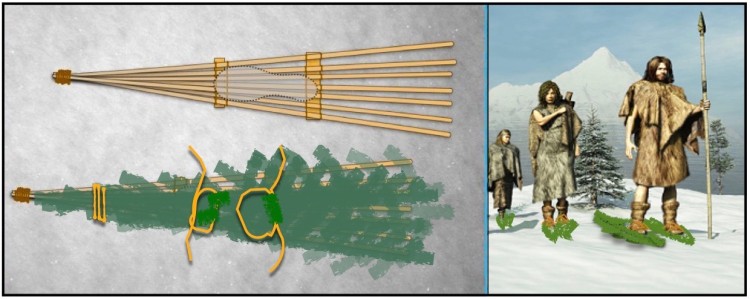
No one knows the first actual scenario for the birth of snowshoeing, but it could date back thousands of years. Photo compilation: Tom Watson
Birth of Snowshoeing
No one knows the actual scenario for the birth of snowshoeing, the first effort or the first culture to develop this historically significant aid to traversing over snow.
In cold-season regions where travel was limited by the number and location of frozen lakes and rivers, activities such as hunting and trading commerce were restricted by how effectively humans could travel by foot across great expanses of snow-covered ground.
It’s commonly surmised that people used snowshoes long before skis (6,000 BC). Historical records of snowshoe history mention “shoeskis” from central Asia consisting of elongated oval planks – half ski/half snowshoe – dating back to about 4,000 BC.
Archival drawings from Scandinavia show a man leading a horse over snow, using round, wooden planks on their feet to spread their weight over the snow. If fact, the earliest form of snowshoes were probably rounded discs covered with leather or fur (a common style reflected in several samples of snowshoes throughout Europe and Asia).
The estimated timeframe of immigration from Asia to North America via Bering Sea routes spanned 30,000 to 5,000 years ago. During this time, they presumably relied upon existing snowshoe technology among those cultures to make such crossings easier.
Artifacts show that, with minor variations, all the Euro-Asian cultures developed a similar oval/circular pad and most likely used them along those land bridge immigration routes.
Read More: Use of Snowshoes in the First Crossing of Greenland
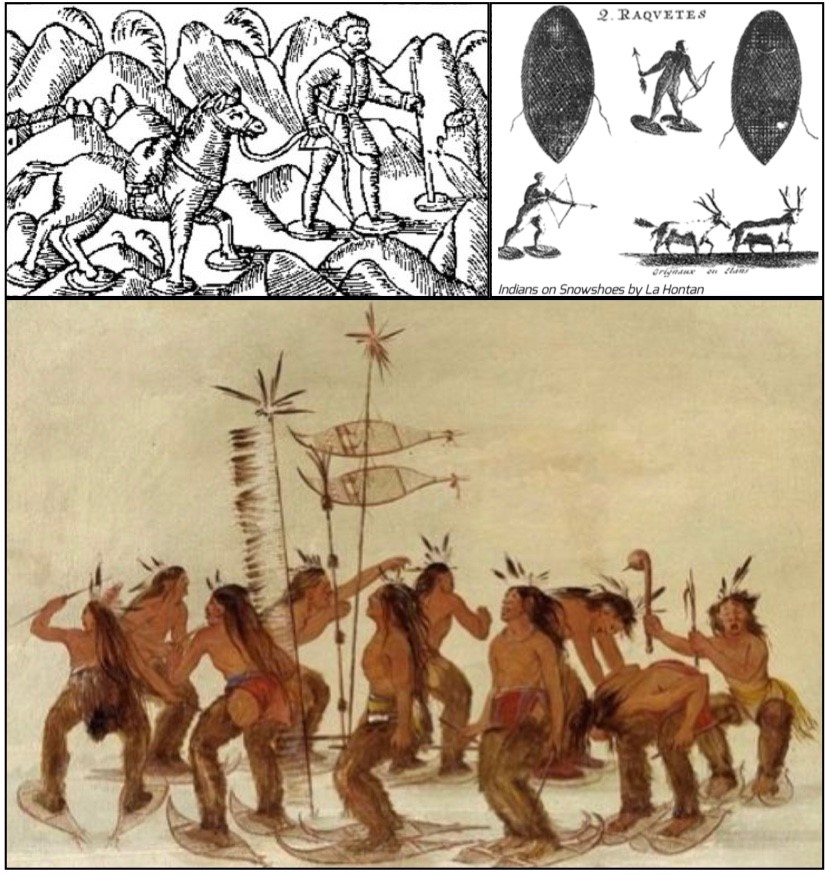
Top L: 16th-century Swedish sketch of a man and horse wearing snowshoes made of wooden planks; Top R: “Raquetes” drawn by La Hontan; Bottom: Plains Ojibwa performing a snowshoe dance, drawn by George Catlin
Evolution of Snowshoe Styles and Designs
Those ancient northern snowshoe cultures reached from Scandinavia across Asia, all the way to the wintry realms of the United States. Here, the form of traditional, wood-framed/laced shoes unfolded.
During this time in snowshoe history, the development and perfection of snowshoe styles by the Native Americans continued throughout the open grasslands and forested regions of the northern great plains, eastward through the Great Lakes regions of the U.S. and Canada, and beyond.
Indigenous styles of snowshoes reflected the environment (terrain, climate, practical use) and culture of the Native Americans who used them. Four basic designs emerged from those prehistoric designs. Indigenous cultures carried them forward, each style modified to enhance a specific application.
Read More: Traditional Wooden Snowshoes: Shapes, Designs, and Names
Alaskan/Yukon
Athabascan designs feature an elongated frame (some over six feet long) with a rounded, turned-up toe. This style was suited for traversing open, powdery snow-covered country; Inuit designs were the more prehistoric, prominently round/triangular shaped frames. Moving further south and eastward, the form of snowshoes became more distinct.
Ojibwe
Eastern North American-Canadian Great Lakes region featured a longer, narrower frame with an upturned pointed nose and pointed tail.
Read More: Connecting to Lineage: Crossing Paths on My Ojibwa Snowshoes
Huron/Michigan/Maine
A shorter, wider version of the Alaskan/Yukon, it’s probably the most commonly recognized style (tear-drop, beaver-tail, or racquet shape). These snowshoes are more suitable for various snow conditions and are common in the St. Lawrence region of Canada and the United States.
Bear Paws
The Bear Paw is an even shorter, oval-shaped snowshoe. It is probably the oldest snowshoe shape of all models and is common among many cultures. Its size makes it suitable for close-in work in forested or other confined, less open areas.
Read More: Snowshoes and the Canadian First Nations
Modern/Ellipse Shape
A fifth style, the Modern/Ellipse shape, evolved from the Bear Paw shape as materials and technology inspired new snowshoe designs.
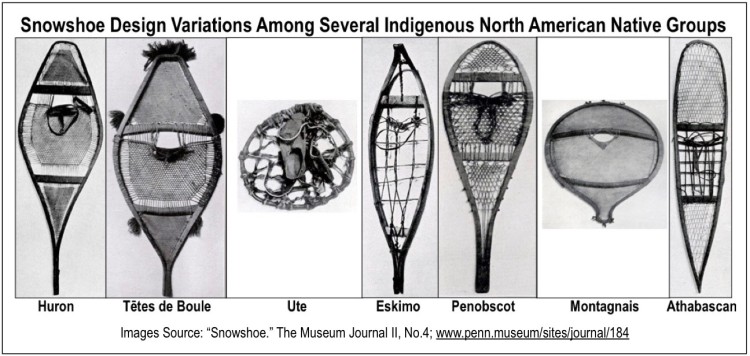
Indigenous styles of snowshoes reflected the environment and culture of the Native Americans who used them. Photo Source: The Museum Journal II, Photo compilation: Tom Watson
Practical Uses Surge
European immigrants to North America found no roads upon which to travel. So, this scenario forced them to adapt to the indigenous lifestyle, including the means of foot transportation. Throughout snowy winters, down/across frozen rivers/streams, or through snow-covered forests or open expanses, they traveled with the use of snowshoes.
Early 1600 French explorers and settlers documented some of the earliest recorded accounts of using this new form of footwear in snowshoe history. In 1608, Samuel de Champlain, the founder of Quebec, described native wintry footwear used by the Huron and Algonquins as much larger and longer than those used in Europe. The French used the term “raquette de neige,” translating to “snowshoe.”
By the 17th Century, numerous French military operations used snowshoes, including extended marches and equipping soldiers in various battles against the British. In fact, two engagements in the French and Indian Wars are referred to historically as the “Battle on Snowshoes.” By the late 1600s, the Brits had also adapted snowshoes as part of their war gear.
Read More: The Saga of Michigan’s Snowshoe Priest
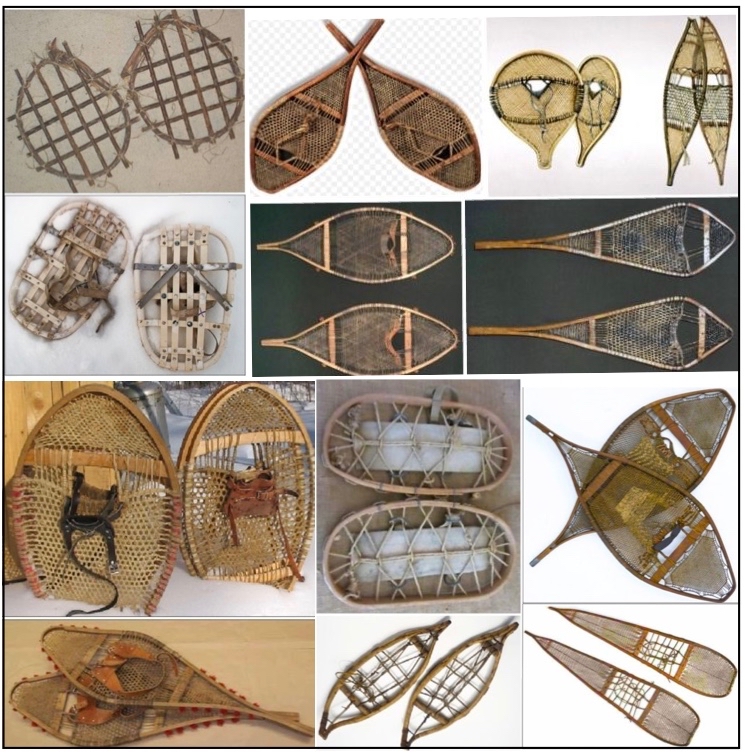
Various snowshoe styles are created based on the environment and intended use. Photo compilation: Tom Watson
New Means of Recreation and Competition
Snowshoes maintained a limited, utilitarian profile for the next two centuries (military, forestry, trappers, etc.). Then, in the 1800s, as the next phase of snowshoe history, Canadian users realized snowshoe attributes as a new means of recreation, which soon developed into enthusiasts forming snowshoe clubs.
Established in 1840, the Montreal Snowshoe Club organized snowshoe races. In these races, the desire for more speed underfoot led to the creation of even more competitive clubs and events.
Founded in 1907, the Canadian Snowshoe Union (Union Canadienne des Raquetteurs) expanded to include over 70 clubs across Canada by 1924. This same year, individuals organized the first American club in Maine and held its first International Snowshoe Congress. Then, one year later, enthusiasts formed the American Snowshoe Union.
Recreational and competitive snowshoeing continued to advance even further with the formation of the Snowshoe Sports International Committee, organized in 1932. More recently, the United States Snowshoe Association was founded in 1977.
Read More: Run, Rabbit, Run: Transition from Running to Snowshoe Racing
The Dawn of the “Modern” Snowshoe
Traditional wooden-framed snowshoes for leisure use endured as a niche market until the next major phase of its history began emerging in the 1950s – the dawn of the “western” snowshoe.
Technology in developing and applications of new materials and manufacturing processes enabled innovative designers to create new shapes and features for snowshoes. These designs forever changed snowshoe utility and expanded options for their uses.
Manufacturers created frames, once formed by bending ash and laced with rawhide strips, with molded tubing or cast polymers and spanned with neoprene or polyethylene decking.
In addition, advances in bindings, cleats/crampons, and other tracking aids made the snowshoe a more efficient “machine” throughout various snow/ice conditions. These first changes in design continued to be modified to become what was known by the 1980s as the “modern” style snowshoe!
Read More: Definitive Guide: How To Choose Snowshoes for Your Needs
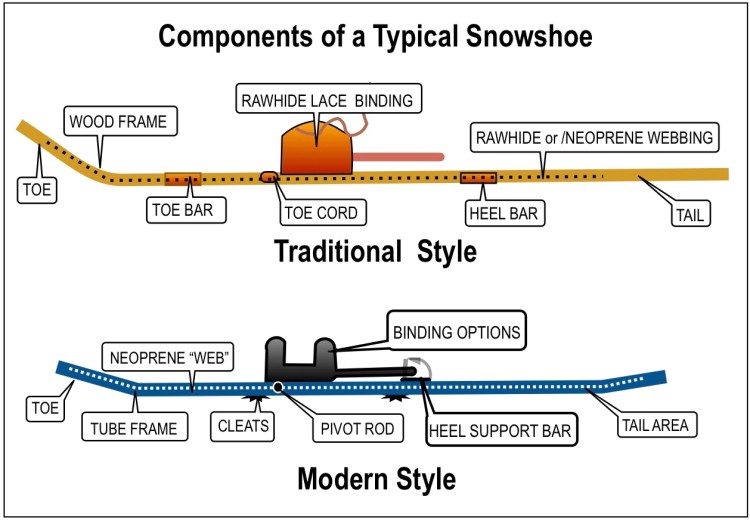
Technology and material advancements enabled innovative designers to create new snowshoe shapes and features. Photo: Tom Watson
Innovations Abound
The changes began with modifying classic, traditional snowshoe forms in 1950. At this time, the Vermont snowshoe company, Tubbs, created the Green Mountain Bearpaw featuring an even narrower frame. Then, in 1972, Bill and Gene Prater designed the Sherpa snowshoe for mountain country use. This snowshoe featured an aluminum frame with neoprene decking and traction cleats.
Soon other companies followed. Redfeather featured a beaver tail aluminum frame with Hypalon decking in 1995. Then, MRS introduced the one-piece plastic decked shoe in 1995, quickly followed by others a year later.
Snowshoe manufacturers incorporate innovative designs and accessories into modern snowshoes every year, some of which include:
- Spring-loaded Suspension with extra traction control (Atlas Snowshoe Company)
- BOA Fit System on-the-fly adjustments (BOA Fit System)
- Snowshoes for climbing inclines straight/laterally without losing grip/backcountry use (Mountain Safety Research)
- Flexible frames that adapt to uneven terrain, crampons, and traction bar for mountain terrain/backcountry use (TSL Outdoor)
Other innovations include but are not limited to: tension adjusting cables on bindings, multiple positioned crampons, and heel bar risers. These innovations are in various shapes and high-tech-constructed ‘modern’ snowshoes.
Read More: 7 Beginner Snowshoes for Varied Terrain
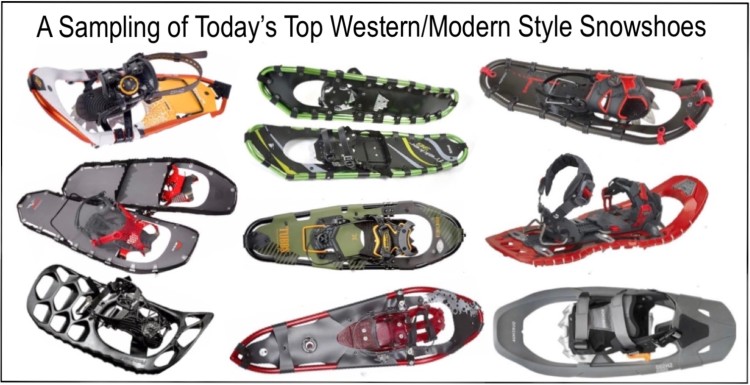
Snowshoe manufacturers incorporate innovative designs and accessories into modern snowshoes every year. The snowshoes above are just a few examples. Photo compilation: Tom Watson
Overall
The history of snowshoes began thousands of years ago. It stretched many miles across three continents to become firmly established in the cultures of the indigenous inhabitants of North America.
Whether you prefer the classic design and lore of the traditional wooden-framed models or the neo-technical “modern” snowshoe of today, we should remind ourselves of the rich history and legacy of the snowshoe every time we step out and leave its impression on the new-fallen snow.
Additional Resources
Helpful sources of historic photos and descriptions of traditional snowshoes can be found at:
Hudson Museum
Penn Museum
GV 1959
U.S Forest Service
Wikipedia
Worldwide Running
How have you seen snowshoes change over the years? What aspects of snowshoeing’s history resonate with you? Please share your thoughts with us in the comments below.
Read Next: A Few U.S. Artisans Keep Traditional Snowshoes a Tradition

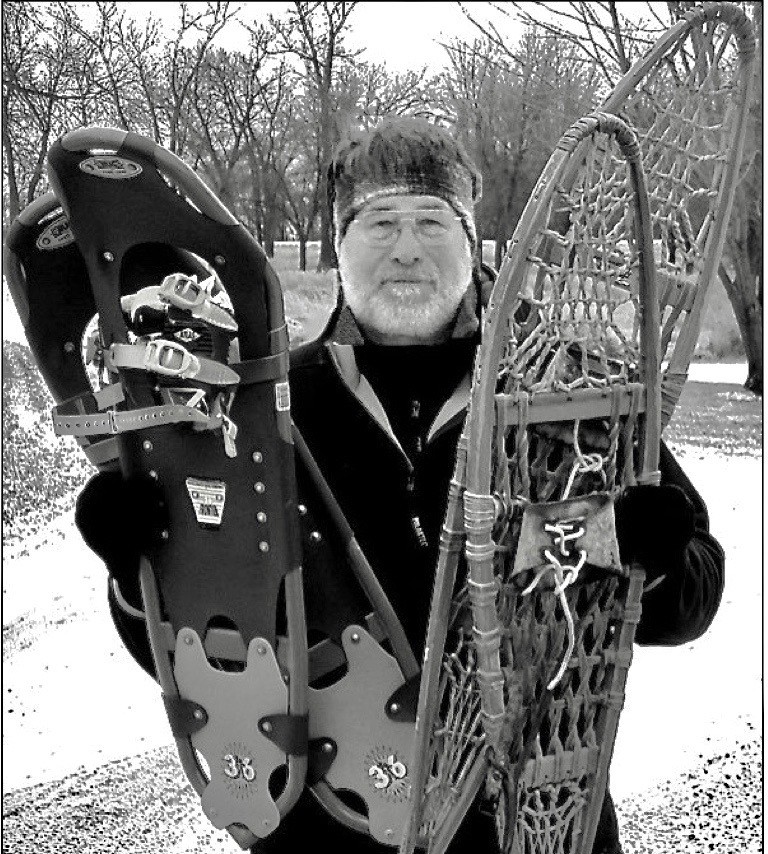
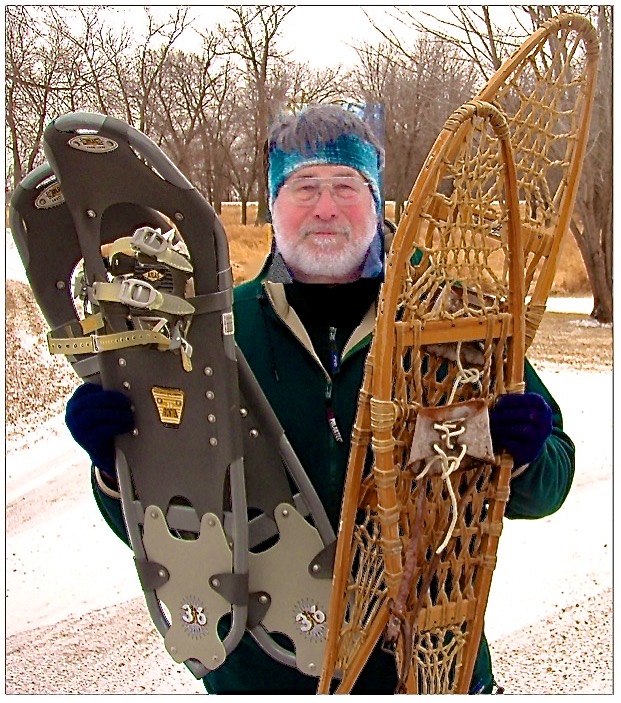
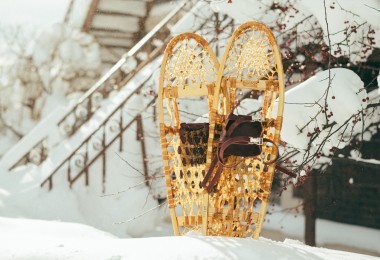
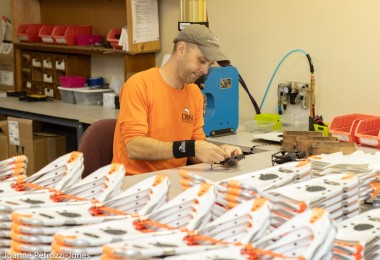
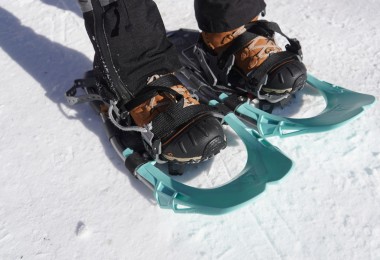
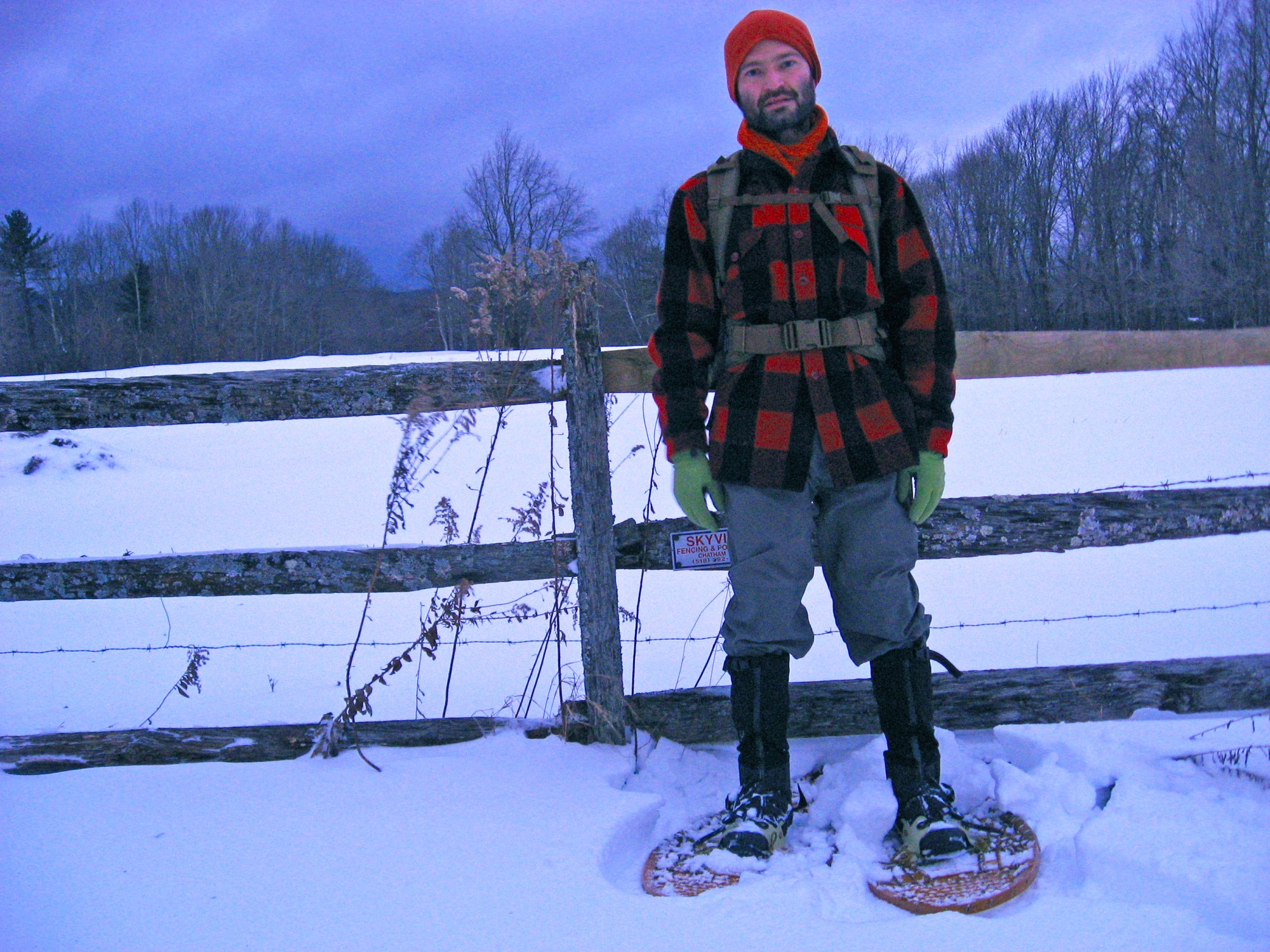

Fantastic description of making snowshoes during the Donner Party catastrophe of 1846 when crossing into California.
Donner Party Dairies-by Daniel M. Rosen
Sunday, December 13, 1846
“Sunday 13th Snows faster than any previous day wind N.W. Stanton & Graves with Several others makeing preperations to cross the Mountains On Snow shoes, snow 8 feet deep on the level dull”
McGlashan recounts the making of the snowshoes: “Mr. F.W. Graves was a native of Vermont, and his boyhood days had been spent in sight of the Green Mountains. Somewhat accustomed to snow, and to pioneer customs, Mr. Graves was the only member of the party who understood how to construct snow-shoes. … By carefully sawing the ox-bows into strips, so as to preserve their curved form, Mr. Graves, by means of rawhide thongs, prepared very serviceable snow-shoes.”
I have a pair ov clckekers. Dateting from the early 1980s
I have some collectable traditionnal snowshoes from Indigenous of Eastern Canada’s Indigenous as Cree, Montagnais, Naskapis. I also have about 200 traditional objects.
I am looking for a person, group or institution interested in acquiring my collection. I worked 38 years for the Department of Indian and Inuit Affairs of Canada.
Best regards
Marc Langlois
One of the biggest innovations in snowshoes that you have not touched upon is the SnowXu Collapsible Snowshoe – the world’s ONLY folding snowshoe. This was featured in a Snowshoe Magazine artice by Philip Gary Smith about 10 years ago. SnowXu has been quiet lately – but is not gone. You could actually be helpful in spreading this innovation throughtout the industry. SnowXu got great reviews from almost all users – and deserves to be recognized.